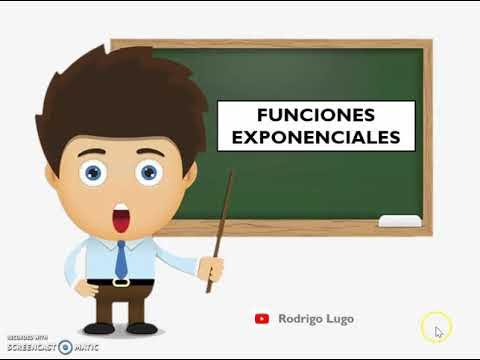PERSAMAAN EKSPONEN BENTUK 1-3 | MATEMATIKA PEMINATAN KELAS 10
Summary
TLDRThis video from the Artimatika channel teaches 10th-grade students how to solve exponential equations, a common topic in national exams. It covers three main types: simple equations like a^x = 1, equations with the same base where exponents are equated, and equations where both sides are powers as functions of x. The instructor explains step-by-step methods, demonstrates examples, and highlights key rules such as converting bases and ensuring positive, non-one bases. Emphasis is placed on practice and understanding patterns, helping students confidently solve various exponential equations and prepare effectively for exams.
Takeaways
- 😀 Exponential equations are mathematical equations that contain exponents or powers.
- 😀 There are three common forms of exponential equations frequently appearing in exams.
- 😀 Form 1: Simple exponential equation where if a^x = 1, then x = 0, given a > 0 and a ≠ 1.
- 😀 Form 2: Same-base exponential equation where if a^{f(x)} = a^{g(x)}, you can solve by equating the exponents f(x) = g(x).
- 😀 When the bases are different, rewrite them as powers of the same base before equating the exponents.
- 😀 Form 3: Exponential equations where the exponents are functions of x, solved by equating the exponents if the bases are the same.
- 😀 Example problems demonstrate step-by-step solving methods for each form.
- 😀 Always check that the base is positive and not equal to 1 before equating exponents.
- 😀 Practicing these three forms thoroughly helps in understanding and memorizing the solving strategies for exams.
- 😀 The video emphasizes clear explanations, using power rules and base conversion techniques to simplify solving exponential equations.
- 😀 For more complex equations, break down the problem by expressing numbers as powers of a common base and then equate the exponents.
Q & A
What is an exponential equation?
-An exponential equation is a mathematical equation in which the variable appears in the exponent.
What are the conditions for solving the exponential equation form a^x = 1?
-The base a must be positive and not equal to 1. If these conditions are met, the solution is x = 0.
How do you solve an exponential equation when both sides have the same base, like a^f(x) = a^g(x)?
-If the bases are the same and satisfy a > 0 and a ≠ 1, you can equate the exponents: f(x) = g(x), then solve for x.
What should you do if the bases in an exponential equation are different?
-Rewrite both sides using the same base, often by expressing them as powers of a common number, and then equate the exponents.
What is the general approach for solving exponential equations with roots, like √4^(2x+4) = 2^(x+5)?
-Convert the root into an exponent (√4 = 4^(1/2) = 2), then rewrite both sides with the same base and equate exponents to solve.
What are the three common forms of simple exponential equations discussed in the video?
-Form 1: a^x = 1; Form 2: a^f(x) = a^g(x); Form 3: f(x)^a = g(x)^a.
Why is it important that the base is positive and not equal to 1 in exponential equations?
-Because if the base is negative or equal to 1, the exponent rules used to solve the equation may not apply correctly or may give undefined results.
In the example 2^(2x+1) = 16, how do you solve for x?
-Rewrite 16 as 2^4, then equate exponents: 2x+1 = 4, solving gives x = 1.5.
How do you solve an equation like 4^(2x+1) = 8^(-6) when the bases are different?
-Rewrite both sides with base 2: 4 = 2^2 and 8 = 2^3, so (2^2)^(2x+1) = (2^3)^(-6), simplify exponents: 4x+2 = -18, solve for x: x = -5.
What is the main tip for quickly solving exponential equations in exams according to the video?
-Practice frequently and focus on recognizing the three common forms of exponential equations, rewriting bases to be the same, and equating exponents when possible.
How do you solve an equation where the exponent itself is a function of x, like 2^(2x+1) = 2^(x+5)?
-Equate the exponents: 2x+1 = x+5, then solve the resulting linear equation: x = 4.
What exponent property is crucial when solving equations where a power is raised to another power?
-The property (a^m)^n = a^(m*n) is crucial, allowing you to multiply exponents when one power is raised to another.
Outlines

Dieser Bereich ist nur für Premium-Benutzer verfügbar. Bitte führen Sie ein Upgrade durch, um auf diesen Abschnitt zuzugreifen.
Upgrade durchführenMindmap

Dieser Bereich ist nur für Premium-Benutzer verfügbar. Bitte führen Sie ein Upgrade durch, um auf diesen Abschnitt zuzugreifen.
Upgrade durchführenKeywords

Dieser Bereich ist nur für Premium-Benutzer verfügbar. Bitte führen Sie ein Upgrade durch, um auf diesen Abschnitt zuzugreifen.
Upgrade durchführenHighlights

Dieser Bereich ist nur für Premium-Benutzer verfügbar. Bitte führen Sie ein Upgrade durch, um auf diesen Abschnitt zuzugreifen.
Upgrade durchführenTranscripts

Dieser Bereich ist nur für Premium-Benutzer verfügbar. Bitte führen Sie ein Upgrade durch, um auf diesen Abschnitt zuzugreifen.
Upgrade durchführenWeitere ähnliche Videos ansehen
5.0 / 5 (0 votes)






